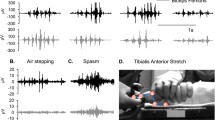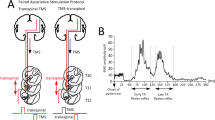Abstract
The aim of this study was to identify the characteristics of the flexion withdrawal reflex modulated by the hip angle and hip movement in spinal cord injury (SCI). The influence of the hip position and passive movement were tested in 6 subjects with chronic SCI. Each subject placed in a supine position and lower leg was fixed with the knee at 5–45 degree flexion and the ankle at 25–40 degree plantar flexion. A train of 10 stimulus pulses were applied at 200 Hz to the skin of the medial arch to trigger flexion reflexes. From results of the regression analysis, static properties of normalized muscle activation of flexor muscles have the linear relationship with respect to hip angle (P<0.05). In order to verify the neural contribution of flexion reflex, we compared the static and dynamic gains of estimated muscle activations with measured EMG of ankle flexor muscle. Form this study, we postulate that the torque and muscle response of flexion withdrawal reflex have linear relationship with hip angle and angular velocity.
Similar content being viewed by others
References
Baxendale, R. H. and Ferrell, W. R., 1980, “Modulation of Transmission in Flexion Reflex Pathways by Knee Joint Afferent Discharge in the Decerebrate Cat,”Brain Research, Vol. 202, pp. 497–500.
Brand, R. A., Pedersen, D. R. and Friederich, J. A., 1986, “The Sensitivity of Muscle Force Predictions to Changes in the Physiologic Crosssectional Area,”Journal of Biomechanics, Vol. 19, pp. 589–596.
Brooke, J. D., McIlroy, W. E., Staines, W. R., Angerilli, P. A. and Peritore, G. F., 1999, “Cutaneous Reflexes of the Human Leg During Passive Movement,”Journal of Physiology, Vol. 518, pp. 619–628.
Brown, D. A. and Kukulka, C. G., 1993, “Human Flexor Reflex Modulation During Cycling,”Journal of Neurophysiology, Vol. 69, pp. 1212–1224.
Delp, S. L., Loan, J. P., Hoy, M. G., Zajac, F. E., Topp, E. L. and Rosen, J. M., 1990, “An Interactive Graphics-Based Model of the Lower Extremity to Study Orthopaedic Surgical Procedures,”IEEE Transactions on Biomedical Engineering, Vol. 37, pp. 757–767.
Dimitrijevic, M. R. and Nathan, P. W., 1968, “Studies of Spasticity in Man 3. Analysis of Reflex Activity Evoked by Noxious Cutaneous Stimulation,”Brain, Vol. 91, pp. 349–368.
Duysens, J. and Van de Crommert, H. W., 1998, “Neural Control of Locomotion; The Central Pattern Generator from Cats to Humans,”Gait & Posture, Vol. 7, pp. 131–141.
Field-Fote, E. C., 2000, “Spinal Cord Control of Movement: Implications for Locomotor Rehabilitation Following Spinal Cord Injury,”Physical Therapy, Vol. 80, pp. 477–484.
Friederich, J. A. and Brand, R. A., 1990, “Muscle Fiber Architecture in the Human Lower Limb,”Journal of Biomechanics, Vol. 23, pp. 91–95.
Granat, M.H., Heller, B.W., Nicol, D.J., Baxendale, R. H. and Andrews, B. J., 1993, “Improving Limb Flexion in FES Gait Using the Flexion Withdrawal Response for the Spinal Cord Injured Person,”Journal of Biomedical Engineering, Vol. 15, pp. 51–56.
Graupe, D., 2002, “An Overview of the State of the art of Noninvasive FES for Independent Ambulation by Thoracic Level Paraplegics,”Neurological Research, Vol. 24, pp. 431–442.
Grillner, S. and Rossignol, S., 1978, “Contralateral Reflex Reversal Controlled by Limb Position in the Acute Spinal Cat Injected with Clonnidine,”Brain Research, Vol. 144, pp. 411–414.
Hiebert, G. W., Whelan, P. J., Prochazka, A. and Pearson, K. G., 1996, “Contribution of Hind Limb Flexor Muscle Afferents to the Timing of Phase Transitions in the Cat Step Cycle,”Journal of Neurophysiology, Vol. 75, pp. 1126–1137.
Hill, A. V., 1938, “The Heat of Shortening and the Dynamic Constants of Muscle,”Proceedvings of the Royal Society of London, Vol. 126B, pp. 136–195.
Hornby, T. G., Tysseling-Mattiace, V. M., Benz, E. N. and Schmit, B. D., 2004, “Contribution of Muscle Afferents to Prolonged Flexion Withdrawal Reflexes in Human Spinal Cord Injury,”Journal of Neurophysiology, Vol. 192, pp. 3375–3384.
Kirkwood, P. A., Schomburg, E. D. and Steffens, H., 1987, “Facilitatory Interaction in Spinal Reflex Pathways From Nociceptive Cutaneous Afferents and Identified Secondary Spindle Afferents in the Cat,”Experimental Brain Research, Vol. 68, pp. 657–660.
Lam, T. and Pearson, K. G., 2002, “Sartorius Muscle Afferents Influence the Amplitude and Timing of Flexor Activity in Walking Decerebrate Cats,”Experimental Brain Research, Vol. 147, pp. 175–185.
Lee, K. H. and Johnston, R., 1976, “Electrically Induced Flexion Reflex in Gait Training of Hemiplegic Patients: Induction of the Reflex,”Archives of Physical Medicine Rehabilitation, Vol. 57, pp. 311–314.
Lundberg, A., 1979, “Multisensory Control of Spinal Reflex Pathways,”Progress in Brain Research, Vol. 50, pp. 11–28.
Schmit, B. D., McKenna-Cole, A. and Rymer, W. Z., 2000, “Flexor Reflexes in Chronic Spinal Cord Injury Triggered by Imposed Ankle Rotation,”Muscle & Nerve, Vol. 23, pp. 793–803.
Schmit, B. D., Benz, E. N. and Rymer, W. Z., 2002, “Afferent Mechanisms for the Reflex Response to Imposed Ankle Movement in Chronic Spinal Cord Injury,”Experimental Brian Research, Vol. 145, pp. 40–49.
Schmit, B. D., Hornby, T. G., Tysseling-Mattiace, V. M. and Benz, E. N., 2003, “Absence of Local Sign Withdrawal in Chronic Human Spinal Cord Injury,”Journal of Neurophysiology, Vol. 90, pp. 3232–3241.
Shahani, B. T. and Young, R. R., 1971, “Human Flexor Reflexes,”Journal of Neurology, Neurosurgery, and Psychiatry, Vol. 34, pp. 616–627.
Sherrington, C. S., 1910, “Flexion-Reflex of the Limb, Crossed Extension-Reflex and Reflex Stepping and Standing,”Journal of Physiology, Vol. 40, pp. 28–121.
Spaich, E. G., Arendt-Nielsen, L. and Andersen, O. K., 2004, “Modulation of Lower Limb Withdrawal Reflexes During Gait: A Topographical Study,”Journal of Neurophysiology, Vol. 91, pp. 258–266.
Steffens, H. and Schomburg, E. D., 1993, “Convergence in Segmental Reflex Pathways from Nociceptive and Non-nociceptive Afferents to a Motoneurons in the Cat,”Journal of Physiology, Vol. 466, pp. 191–211.
Zajac, F. E., 1989, “Muscle and Tendon: Properties, Models, Scaling and Application to Biomechanics and Motor Control,”CRC Critical Reviews in Biomedical Engineering, Vol. 17, pp. 359–411.
Zehr, E. P., Hesketh, K. L. and Chua, R., 2001, “Differential Regulation of Cutaneous and H-Reflexes During Leg Cycling in Humans,”Journal of Neurophysiology, Vol. 85, pp. 1178–1184.
Author information
Authors and Affiliations
Corresponding author
Rights and permissions
About this article
Cite this article
Kim, Y., Youm, Y. Identification of flexion withdrawal reflex using linear model in spinal cord injury. J Mech Sci Technol 20, 1183–1194 (2006). https://doi.org/10.1007/BF02916017
Received:
Revised:
Issue Date:
DOI: https://doi.org/10.1007/BF02916017




